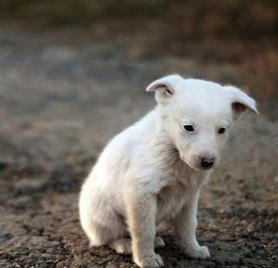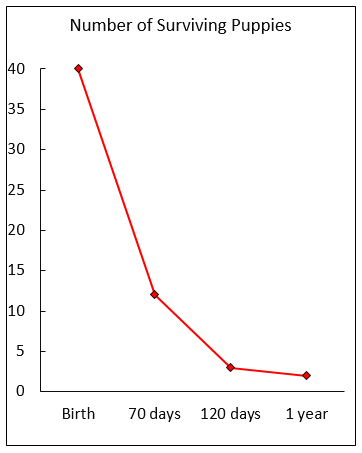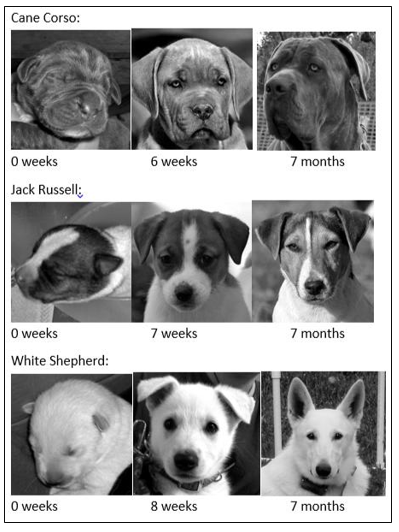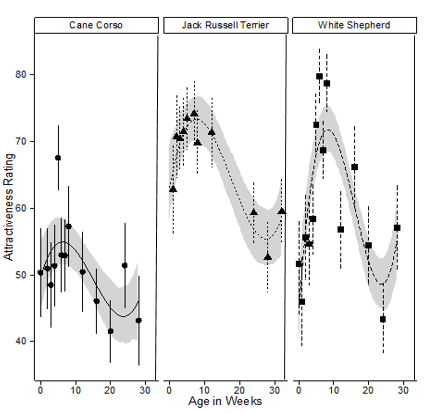There are about a billion dogs on Earth, and according to Ray and Lorna Coppinger, authors of the new book What Is a Dog?, 85 percent of them are not pets. Indeed,the vast majority of dogs on the planet run wild. These animals are often referred to as pariah dogs, street dogs, village dogs, and garbage dump dogs.

They do hang around human habitations, but they will never sleep in a bed, wear a collar, or receive even rudimentary veterinary care. But their testicles and ovaries will remain intact, they spend all day with their pals, and generally do what the want to. However, freedom has its costs: Diseases, automobiles, and starvation all take their toll.
Yet even with these risks, Ray Coppinger argues that an adult dog living in a Nairobi garbage dump has a better life than a Beverly Hills poodle. But this is not true of the puppies: The infant mortality rate among the

world’s street dogs is horrendous. This graph shows the survival rate of 40 newborn Italian village dog puppies. Seventy percent died before they were 10 weeks old, and only two lived to the age of 12 months. Other studies have found similarly high death rates among puppies in Kenya, India, Mexico, and the Bahamas.
Why will 80 or 90 percent of the world’s feral dogs never make it to their first birthday? The reason is that female dogs typically abandon their pups when they are two or three months old. (Wolf mothers, in contrast, look after their offspring for two years.) So what is the key to survival for a puppy born at the big dump in Mexico City? Tricking a person into adopting and taking care of it. And as the Coppingers note, it helps a lot if people think the puppy is cute.
The Hypothesis: Dogs Should Be Cutest When They Need Help The Most
Dogs and humans have been hanging out together for between 14,000 and 20,000 years, and for nearly all of this time, the canine ecological niche resembled that of village dogs. A University of Florida research team headed by psychologist and dog researcher Clive Wynne team reasoned that if a pup’s survival depended on its being adopted by a person, the genes of particularly cute puppies would be more likely make it to the next generation. Further, because selection pressure is particularly intense when animals are abandoned by their mothers, puppies should be at their most adorable around the time they are being weaned, between six and 11 weeks.
The Experiment
The investigators tested this hypothesis by having people rate the attractiveness of photographs of 39 dogs taken between the time they were born and 30 weeks later. The photos were all head shots with neutral backgrounds and the same level of brightness.

They represented three diverse breeds:
- Cane Corsos are sometimes called “the Italian mastiff.” They are large, dark-colored dogs originally bred for guarding and hunting animals such as wild boar.
- Jack Russell Terriersare small energetic dogs that originally bred for fox hunting. They are typically white or light colored.
- White Shepherdsare an all-white variant of the German Shepherd Dog. It is recognized by some kennel clubs as a separate breed.
The photographs were presented on a computer. Fifty-one college students rated the attractiveness of each dog on a scale of 0 (“not at all attractive”) to 100 (“very attractive).
The Results
The results were clear. The attractiveness ratings supported the hypothesis that puppies are most appealing to humans right about the time they are weaned.

The Jack Russells and White Shepards were cutest when they were about eight weeks old and the cuteness of the Cane Corsos maxed out at the age of six weeks. (All three breeds showed an uptick in cuteness when they were 30 weeks old. I have no idea why.)
The Bottom Line….
In 1943, ethologist Konrad Lorenz argued that humans are instinctively attracted tokindchenschema, features of infants that elicit our parental instincts, such as large eyes and bulging craniums. Modern brain research (here) and recent studies of the visual preferences of young children (here) support this idea. We are, in short, suckers for creatures that hook our parental urges. Wynne’s research shows how the human preference for cuteness may have shaped the developmental trajectories of man’s best friend, and why puppies are at their most irresistible exactly when they are most vulnerable.
This study, however, was done in a laboratory with photographs rather than real dogs. Would similar results be found using real puppies in a natural setting? We can’t be sure, but a 1998 field study with an adorable 10-week-old Golden retriever named “Goldie” suggests the answer is yes. Over five months, researchers took Goldie to well-traveled spots on the University of California at Santa Barbara campus and counted the number of passersby who came over to pet or play with her. Goldie’s ability to seduce strangers dropped precipitously over the weeks as she transformed from puppy to adult dog. The decline was particularly steep among women: When Goldie was at her cutest, women were twice as likely as men to chat her up. But by the end of the study, the number of women who stopped to stroke her head and say hi had dropped 95 percent and the sex difference had completely disappeared.
I’m not sure how Goldie would have fared in the Mexico City dump.
(And for evidence that your dog is probably not as cute as you think it is, see this Psychology Today post.)
* * * * *
(This post originally appeared in Animals and Us.)
Hal Herzog is Emeritus Professor of Psychology at Western Carolina University and the author of Some We Love, Some We Hate, Some We Eat: Why It’s So Hard To Think Straight About Animals.
References
- Boitani, L., & Ciucci, P. (1995). Comparative social ecology of feral dogs and wolves.Ethology Ecology & Evolution, 7(1), 49-72.
- Coppinger, R. & Coppinger, L. (2016) What is a dog?Chicago: University of Chicago Press.
- Chersini, N., Hall, N., & Wynne, C. D.L. (2016). Dog pups are most attractive to humans at weaning. Presented at the conference of the International Society for Anthrozoology, Barcelona.
- Fridlund, A. J., & MacDonald, M. J. (1998). Approaches to Goldie: A field study of human approach responses to canine juvenescence. Anthrozoös,11(2), 95-100.
